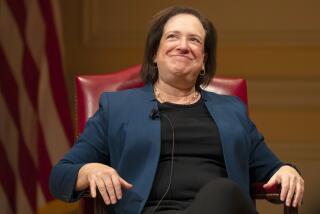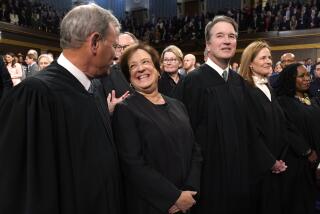U.S. Justices Toss Out Deal in Decades-Old Asbestos Case
In one of the most closely watched mass-injury cases in the nation, the U.S. Supreme Court on Wednesday rejected a proposed $1.3-billion settlement of thousands of asbestos claims.
In a 6-2 decision, the high court said the deal, which would have set up an administrative procedure to resolve all present and future claims against 20 asbestos manufacturers, encompassed too many kinds of people to proceed as a single case.
The ruling could curb similar sweeping judicial resolutions of other mass-injury cases, but it will not have any negative effect on the pending $368.5-billion tobacco settlement, which would require congressional approval, according to legal experts such as Harvard law professor Laurence H. Tribe.
Wednesday’s decision upheld in large part a 1996 decision by the U.S. 3rd Circuit Court of Appeals in Philadelphia that spurned the settlement, which had been approved two years earlier by a federal trial judge there.
Proponents of the deal said it was an efficient, creative solution to judicial gridlock--asbestos cases have been mired in courts for years without resolution. Opponents countered that it was an unconstitutional sellout of people whom the deal purported to help because it capped damages at too low a level and inadequately addressed the needs of those whose have been exposed to asbestos but have not developed diseases.
Numerous studies have shown that people exposed to asbestos have vastly higher rates of lung cancer and other diseases, which can take 15 to 40 years to emerge.
The settlement would have affected between 250,000 and 2 million people, including countless individuals who would have been barred from suing even though they may not have known that they were bound by it, according to lawyers who objected to the deal.
Justice Ruth Bader Ginsburg’s majority opinion said the deal at issue in Amchem Products vs. George Windsor in effect pitted people who suffer from asbestos-related diseases against those who may develop illnesses in the future.
She said that the “sprawling” proposed group of claimants simply did not meet the requirements for a proper class under the federal rules of civil procedure, citing the 3rd Circuit’s description of why the class was insufficiently cohesive:
“Class members were exposed to different asbestos-containing products, for different amounts of time, in different ways and over different periods. Some class members suffer no physical injury or have only asymptomatic [lung-wall] changes, while others suffer from lung cancer, disabling asbestosis or mesothelioma,” a rare cancer of the lungs caused only by asbestos.
Ginsburg stressed that “for the currently injured, the critical goal is generous, immediate payments. That goal tugs against the interest” of people who have been exposed to asbestos but whose diseases have not yet appeared. Those people, she said, would want a settlement that incorporates elements missing from this deal, including an inflation clause and guarantees that future medical research about asbestos-related diseases was taken into account--factors of no moment to a person who desires a resolution now.
In sum, she said, “lumping these diverse groups into a single mass class is inappropriate.” Chief Justice William H. Rehnquist and Justices Antonin Scalia, Clarence Thomas, David H. Souter and Anthony M. Kennedy joined in her opinion. Justice Sandra Day O’Connor did not participate in the case.
The two dissenting justices, Stephen G. Breyer and John Paul Stevens, asserted that the majority overemphasized the vices of the settlement and did not accord sufficient credit to the plan for a nationwide administrative claims procedure that could more swiftly compensate asbestos victims. Indeed, some victims have suffered slow, painful deaths while their cases were pending.
Ginsburg acknowledged that a nationwide administrative procedure might have been “the most secure, fair and efficient means of compensating victims.” However, she said, such a sweeping action went beyond what a judge should do, adding, “Congress has not adopted such a solution.”
The controversial settlement precipitated deep divisions among people normally allied with one another, including the plaintiffs trial bar, legal ethicists and consumer groups. The AFL-CIO favored the deal, saying it was a way to get justice for sick workers who had waited years for compensation. But the Ralph Nader-led Public Citizen group branded the pact as a corrupt, unconstitutional sellout of people it purported to help.
Harvard professor Tribe, who represented several individuals objecting to the settlement, praised the decision: “It’s gratifying and very important that the Supreme Court was as forthright as it could be in blowing the whistle on what seemed to me an extremely dangerous abuse of the class-action process.”
Fred Baron, a Dallas plaintiff’s lawyer who spearheaded the challenge to the settlement, listened to Ginsburg read a summary of the decision at the Supreme Court on Wednesday. “I was very relieved,” Baron said.
“If the court had gone the other way, I don’t think we would ever again see people with latent injuries have the opportunity to get access to the civil justice system and jury trials, because industry would always be able to find a shill of a plaintiffs lawyer who would make a bad deal in the interest of significant attorney’s fees. I hate to say that about my brother lawyers, but it’s true,” Baron said.
The ruling was also praised by several legal scholars and by Brian Wolfman of Public Citizen, who filed a friend-of-the-court brief on behalf of the White Lung Assn. of New Jersey, an asbestos-victims group.
“Everything in this opinion suggests to me that these wildly ambitious legislative-type mass tort settlements are not going to be permissible in federal courts any longer,” Wolfman said. He and others predicted that the decision would result in the overturning of a similar settlement approved by a federal appeals court in New Orleans last year. A petition for review of that case is pending before the Supreme Court.
Columbia University law professor John Coffee also predicted that it would cause a federal judicial commission to reconsider its position on approving a rule that would have paved the way for more settlements of the type rejected by the high court Wednesday.
Lawrence Fitzpatrick, president of the Center for Claims Resolution, the consortium of 20 companies that forged the settlement with a group of plaintiffs lawyers, said he was disappointed with the decision but added that he thought it was possible a new deal could be arranged. In fact, he said discussions have already started.
Charleston, S.C., trial lawyer Ronald L. Motley, whose firm played a key role in formulating the settlement, also said the deal could be restructured, perhaps setting up subclasses such as current claimants, future claimants, heavily injured individuals and moderately injured individuals.
“We tried to do the right thing,” said Motley, one of the nation’s premier asbestos attorneys. “We knew when we went into this that we were pioneers. Sometimes, pioneers get shot with arrows in their butts. We’ll pick the arrows out and keep moving west,” he said.
But Tribe said he thought restructuring the settlement is virtually impossible because the companies agreed to settle the claims only of those currently injured by getting assurances that they would get a cap on the potential liability they could face from people who develop illnesses later.
Wednesday’s decision marks the latest development in the decades-old history of asbestos litigation, described by one scholar as a “high-tech Bleak House,” referring to Charles Dickens’ 19th century story of a British family that gets ensnared in a never-ending legal dispute.
Judges throughout the United States have expressed frustration over how to process hundreds of thousands of pending suits. In 1991, a special committee of the Judicial Conference of the United States appointed by Rehnquist said the litigation had become “a disaster of major proportions to both the victims and the producers of asbestos products” and urged a creative solution, perhaps including congressional action.
Deborah Hensler, director of the Rand Institute of Civil Justice in Santa Monica, who has conducted several studies of asbestos cases, praised the high court for rejecting a settlement “with a lot of questionable aspects,” but said the ruling offered no cure for the basic problem of victims long uncompensated. “It leaves asbestos litigation in the same bad state it’s been in for the last decade--with no clear light at the end of the tunnel,” Hensler said. “I think it’s ironic that we now have Congress contemplating a plan for resolving tobacco litigation when we have not been able for three decades to get Congress to confront the problems of asbestos litigation.”
More to Read
Sign up for Essential California
The most important California stories and recommendations in your inbox every morning.
You may occasionally receive promotional content from the Los Angeles Times.










